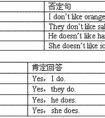句型转换。1. Ilikesocks, too.(变为否定句) 2. Herfavouritecolourisred.(对划线部分提问)3. Ilikegreen. Ilikebrown.(变为同义句) -四年级英语
题文
| 句型转换。 |
| 1. I like socks, too.(变为否定句) 2. Her favourite colour is red.(对划线部分提问) 3. I like green. I like brown.(变为同义句) |
答案
| 1. I don't like socks, either. 2. What's her favourite colour? 3. I like green and brown. |
据专家权威分析,试题“句型转换。1. Ilikesocks, too.(变为否定句) 2. Herfavourite..”主要考查你对 副词,疑问代词,一般现在时,动词单数第三人称,特殊疑问句,连词 等考点的理解。关于这些考点的“档案”如下:
副词疑问代词一般现在时,动词单数第三人称特殊疑问句连词
考点名称:副词
- 副词:
用来修饰动词、形容词、其他副词或全句的词,表示时间、地点、程度、方式等。 - 分 类:
1) 时间和频度副词:
now,then,often,always,usually,early,today, lately, next,last,already,generally,frequently, seldom,ever,never,yet,soon,too, immediately, hardly,finally,shortly, before, ago,sometimes, yesterday.
2) 地点副词:
here, there, everywhere, anywhere, in, out, inside, outside, above, below, down, back, forward, home, upstairs, downstairs, across, along, round , around, near, off, past, up, away, on.
3) 方式副词:
carefully, properly, anxiously, suddenly, normally, fast, well, calmly, politely, proudly, softly, warmly
4) 程度副词:
much,little, very,rather,so,too,still, quite, perfectly, enough, extremely, entirely,almost, slightly.
5) 疑问副词:
how, when, where, why.
6) 关系副词:
when, where, why.
7) 连接副词:
how, when, where, why, whether. 副词的位置:
A、副词修饰动词(包括动名词和分词)时,通常位于被修饰动词的后面。
例:Shestudieshard.她学习努力。
B、副词修饰形容词是,通常放在该形容词的前面。
例:LiMingistooyoung.Hecan’tcarrytheheavybox. 李明太小,他搬不动这个重箱子。
C、副词修饰其他副词时,通常放在被修饰副词的前面。
例:Thegirlsingsverywell.这个女孩歌唱得非常好。副词用法:
副词在句中可作状语,表语,补语。
He works hard.
他工作努力。
You speak English quite well.
你英语讲的很好。
Is she in ?
她在家吗?
Let's be out.
让我们出去吧。
Food here is hard to get.
这儿很难弄到食物。
考点名称:疑问代词
- 疑问代词:
在句子中用来构成特殊疑问句,主要用于询问“何人”、“何事”、“什么”。
常见的疑问代词如下表所示:
疑问代词
替代范围
who
人
whom
人
whose
人
which
人、事、物
what
事、物
考点名称:一般现在时,动词单数第三人称
一般现在时:
表示现在经常反复发生的动作、存在的状态或习惯性的动作的时态。可概括为
①经常性或习惯性动作;
②长期存在的特征或状态;
③普遍真理、客观事实等。
构成:
一般现在时用行为动词的原形,但第三人称单数作主语时,动词的词尾要加-S。
a. 表示经常性或习惯性的动作。
例:Li Ming always helps the old man. 李明一直帮助这位老人。
We usually go to school on foot. 我们通常步行上学。
They sometimes go fishing on Sundays. 他们有时周日去钓鱼。
b. 表示永恒不变的事实或真理。
例:A bird flies with wings. 鸟用翅膀飞翔。
c. 用在格言、谚语中。
例:Pride goes before a fall. 骄者必败。- 一般现在时具体用法:
1.表示经常的或习惯性的动作,常与表示频率的时间状语连用。
时间状语:
always,usually,every morning/night/evening/day/week/year,often,sometimes,
occasionally,from time to time,twice a week,rarely,seldom,once a month,hardly,ever,never.
e.g: I leave home for school at 7:00 every morning.
2.表示主语具备的性格、能力、特征和状态。
e.g:I don't want so much.
Ann Wang writes good English but does not speak well.
比较:Now I put the sugar in the cup.
I am doing my homework now.
3.表示客观事实和普遍真理。
e.g :The earth moves around the sun.
Shanghai lives in the east of China.
- 最新内容
- 相关内容
- 网友推荐
- 图文推荐
| [家长教育] 孩子为什么会和父母感情疏离? (2019-07-14) |
| [教师分享] 给远方姐姐的一封信 (2018-11-07) |
| [教师分享] 伸缩门 (2018-11-07) |
| [教师分享] 回家乡 (2018-11-07) |
| [教师分享] 是风味也是人间 (2018-11-07) |
| [教师分享] 一句格言的启示 (2018-11-07) |
| [教师分享] 无规矩不成方圆 (2018-11-07) |
| [教师分享] 第十届全国教育名家论坛有感(二) (2018-11-07) |
| [教师分享] 贪玩的小狗 (2018-11-07) |
| [教师分享] 未命名文章 (2018-11-07) |

![_____________ are the gifts for you. [ ]A. These B. They C. Here-六年级英语](http://www.00-edu.com/d/file/ks/4/1/42/2019-08-19/smallb74667ee7b98b5f4a02da9ddd66c0d761566229906.gif)
![Whichofthefollowing means "Noleftturn"?[ ]A.B.C.D.-六年级英语](http://www.00-edu.com/d/file/ks/4/1/42/2019-08-19/small2f91397a71cd5ff565aa5e6cae7f65e71566229608.gif)
![LiMing __________ backwards __________.[ ]A.skate,slowB. skates,slowC. skates,slowly-六年级英语](http://www.00-edu.com/d/file/ks/4/1/42/2019-08-19/smalleb33afabbe986bca37acc8f96e3be4f31566229848.png)
![I can't hear you. Please read it ____________.[ ]A. slowlyB. loudlyC. quietly-六年级英语](http://www.00-edu.com/d/file/ks/4/1/42/2019-08-19/smallefe56863e6931564a691a2e6ac7476ef1566230142.jpg)



